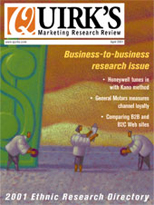Applying lessons learned
Editor’s note: Bill MacElroy is president of Modalis Research Technologies, Inc., San Francisco.
As the Internet’s influence on business has grown, many business-to-business (B2B) sites have been attempting to apply “lessons learned” from the business-to-consumer (B2C) e-commerce experience. Several recent studies have indicated that this strategy is only partially successful.
Although the B2B e-commerce market is projected to grow at many times the corresponding B2C market over the next several years, consumer-targeted commerce has been the focus of most published research. In the studies we’ve had the opportunity to work on, the B2B sites are visited by users with different levels of urgency and with expectations that are similar only to the most sophisticated of consumer users.
One thing that the two types of sites do seem to share is that familiarity with the layout and functionality of an e-commerce site tends to lower the interest in switching out to other, competitive sites. Once someone has learned how a site works, there is a powerful disincentive to start over again and learn new conventions. Initial trial and consummation of a successful transaction are, therefore, critical to converting a visitor to a long-time, repeat customer.
Another aspect common to both consumer- and business-oriented sites is the influence of customization. Like basic familiarity, the more data a customer accumulates with a site (e.g., shipping addresses, credit information, access to account history, customer lists, layout preferences, etc.) the harder it is for a competitive site to lure them away. Sites that incorporate a data-tracking system (allowing the customer to set reminders, automated re-order periods, etc.) erect even more powerful barriers to competitive poaching. As an example of the effectiveness of this strategy, we’ve found that discounts on the order of 30 percent to 50 percent would be required for someone with a deeply ingrained, personalized site to recreate their profile with an equally trustworthy site.
Outside of these two fundamental site characteristics, what the B2B user is seeking tends to diverge quickly from the features of a successful B2C site. The first issue is that speed-of-transaction is far more important to the B2B user than to the average consumer site. To clarify, this is not to say that consumers are tolerant of slow page loads or calculations; but they do tend to tolerate a more circuitous route to the conclusion of the transaction. Business users want to beeline the process with as few distractions as possible.
One artifact of this no-nonsense orientation is that brand-enhancing graphic design tends to be under-appreciated in the B2B environment. Web graphics that “serve no purpose” or are “distracting” provoke negative responses. Heavy use of icons to represent functional or navigational elements is also a design technique to be used cautiously. B2B users give higher effectiveness ratings to sites that employ “bread crumb” text-based navigational aids versus graphic or simple color-coding schemes.
While ease-of-use is a frequently bandied-about attribute that all e-commerce sites should ideally possess, there appears to be a B2B trade-off between the level of difficulty in learning a site’s functionality and its eventual speed of use. In other words, some B2B customers will spend a good deal more time to learn and become proficient in a site with “deep” functionality and personalized data components IF the eventual payoff is a fast and customized transaction. Consumers are much more apt to give up and abandon a site at the first sign of difficult-to-master tasks.
Sensitivity to issues of confidentiality also appears to have a much greater impact on B2C than B2B customers. Although this difference is diminishing as consumers become less wary of using credit cards for online purchases, anxiety over “getting on e-mail lists” or “someone selling my name to telemarketers” remains a serious concern for consumers. B2B customers don’t express these concerns to the same degree if they recognize the value of providing information for customization purposes.
The degree to which transactions are found to be error-free is more important in the B2B world, where the dollar commitments per order are usually greater. Consumers tend to be more tolerant of a certain level of “error” (e.g., wrong sizes, missed shipping commitments, back orders, etc.) due to generally liberal return policies. The one area where zero-tolerance for error is the same for both groups is in the realm of online banking, bill payment, financial transactions and insurance. Anything related to money management is generally held to a higher level of expectation.
A final point of difference that we’ve encountered is the tolerance for out-of-stock positions. B2C customers have reported numerous and repeated experiences with online vendors being back-ordered on at least some portion of their order. Although frustrating, many consumers have stated that they have come to expect it. Sites that give immediate stock positions and/or suggest alternatives help to soothe consumer wrath. B2B customers, however, have little patience for out-of-stocks, particularly on standard items. To paraphrase the words of one respondent, “If they can’t keep copier paper in stock, I need to find a new source.” Stock position feedback functions have little effect on ameliorating B2B frustrations with out-of-stocks. Real-time tracking of order status, however, is highly valued by B2B customers.
In conclusion, the Web site elements that are acceptable for B2C applications are generally less stringent than those for B2B customers. Designing for the more discriminating B2B market means that lessons learned from the more heavily studied B2C sites may need to be updated for business audiences.
